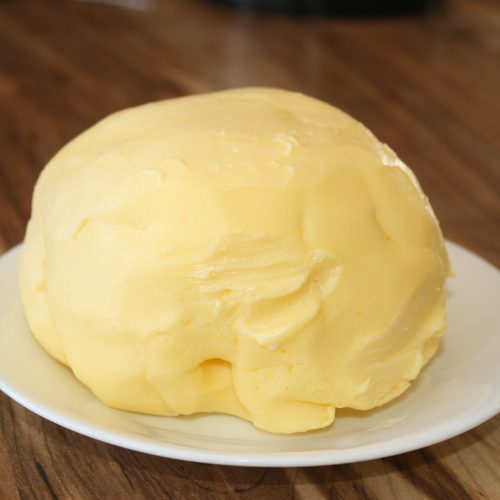In the last couple years, I have seen a lot of excitement over the idea of making butter by shaking cream in a jar until it turns to butter. While that will produce butter and might be fun for the first few minutes, I would probably only do it once (if I even finished the first time). Let’s be real, that would be a lot of work and take a lot of time! I’m so thankful for modern technology that allows us to put good quality food on the table without so much physical labor and time. While I love physical work, I also enjoy accomplishing a lot of tasks in a day, and I that’s why I love making butter with my Bosch mixer. It’s quick and easy.
Over the years (until recently) the family milk cow was considered an essential piece of the homestead and health of the family. I can see why. People of the past saw the value of milk, and I have read numerous examples. During World War 2 in Great Britain, when everything was being rationed and meat production was discouraged, it is interesting to note that families were encouraged to produce as much milk as possible, because they knew it was vital to the health of the country especially the children. This milk would have been raw (not heated) and non-homogenized. These stories that I heard were before our milk changed to the pasteurized, homogenized milk of today that is harder to digest and not as nutrient dense.
June is the best time for making butter. The cows are eating rapidly growing, green grass which transforms that butter into a powerhouse of nutrients, and the cream turns to butter very quickly. A deep yellow color is a great indication of high vitamins, especially vitamin A. You probably won’t find this kind of cream in the store, but if you own a milk cow, or know the right farmer, you can make exceptional quality, flavorful butter all year round.
To make butter we start by taking the cream off the top of the milk. In its natural state, cream will rise to the top of the milk after about 12 hours. I skim this off with 1/3 cup and add about a half-gallon of cream to my Bosch Mixer and turn it on low. During the summer we have noticed that our cream turns to butter in a short amount of time, whereas our winter cream can take an hour to turn. After the cream turns to butter (there’s usually a change in the sound of the mixer), you will notice there are chunks of butter mixed with buttermilk (looks like thin milk). We simply strain off the buttermilk and then work the butter until most of the buttermilk is out, salt it, let it sit for several minutes and then work it again.
Each week I make about 7 pounds of butter. When I was buying organic, pastured butter (I’m not convinced that it was really pastured) it was about $5 per pound. I heard it’s around $8 a pound at this time. By making butter each week, we are saving our family $35 per week and that’s about $1820 per year. Since we move our cows on pasture during the growing season, and cut our own hay, our costs are not as high, but we have a lot of time in producing it. The cost will be different for everyone, but we have figured a significant savings by making our own butter, and more importantly we know we are getting a great quality butter!
Have you made butter? We love to hear from you!
A note on my mixer: I have owned a Bosch mixer for about 10 years, and we used it almost every day. I love my Bosch for making butter, because it has a lid and keeps the liquid contained, unless I add more than a half-gallon of cream. One thing I didn’t like about my mixer was how loud it was. Recently my Bosch quit working and we invested in a new Bosch. I love this one even more because it’s not as loud, and it has a stainless-steel bowl. I also use/used this for making sourdough bread products. I am not compensated for sharing this, but love the product and the company in the link.

Homemade Butter
Ingredients
- 1-2 quarts cream
- 1-2 tsp. Real Salt
Instructions
- Take cream off the top of milk. Add a quart to a half-gallon of cream to a Bosch Mixer or 1 pint to a Kitchen Aide mixer and turn it on low. Watch and listen for the cream to turn to butter. This can take an hour with winter cream. After the cream turns to butter (there’s usually a change in the sound of the mixer), you will notice there are chunks of butter mixed with buttermilk (looks like thin milk). Simply strain off the buttermilk and then form the butter into a ball and kneed it with your hands or a paddle until most of the buttermilk is out. It helps to rinse it with cold water a few times as you are kneading. After most of the buttermilk is removed, salt it, let it sit for several minutes (allowing the salt to pull more liquid) and then work it again until no milk comes out.

